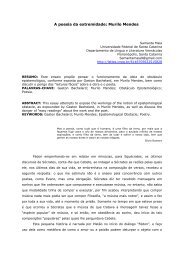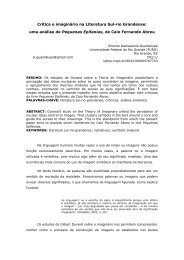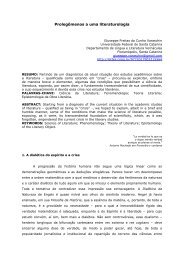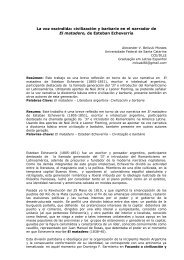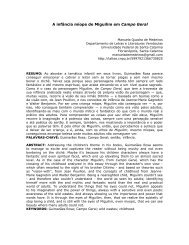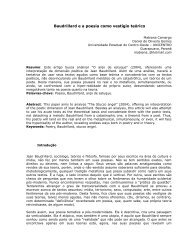Incongruity and Comicality in Woody Allen's prose
Incongruity and Comicality in Woody Allen's prose
Incongruity and Comicality in Woody Allen's prose
You also want an ePaper? Increase the reach of your titles
YUMPU automatically turns print PDFs into web optimized ePapers that Google loves.
pa<strong>in</strong>s. Life is hard for <strong>in</strong>sects. And don’t th<strong>in</strong>k mice are hav<strong>in</strong>g any fun,<br />
either. The po<strong>in</strong>t is, we all need a nest egg to fall back on, but not while<br />
wear<strong>in</strong>g a good suit. (ALLEN, 1991, p. 63)<br />
Tak<strong>in</strong>g this same procedure ahead, <strong>in</strong> the follow<strong>in</strong>g essay “On Love”<br />
Allen also makes use of the major premises which form the basis of some<br />
commonplaces, now related to love, <strong>and</strong> aga<strong>in</strong> he subverts their expected<br />
conclusions, as may be attested right <strong>in</strong> the beg<strong>in</strong>n<strong>in</strong>g of the text: “Is it better to<br />
be the lover or the loved one? Neither, if your cholesterol is over six hundred;”<br />
(Ibid.) or <strong>in</strong> the third paragraph: “Beauty is <strong>in</strong> the eye of the beholder. Should the<br />
beholder have poor eyesight, he can ask the nearest person which girls look good.”<br />
(Ibid., p. 64) In a sense, perhaps, it is possible to say that Allen’s comic persona<br />
is act<strong>in</strong>g like a sophist here, s<strong>in</strong>ce he <strong>in</strong>itially makes use of valid or effective<br />
arguments, that is, arguments symbolically recognized as truths, or as accepted<br />
op<strong>in</strong>ions or beliefs shared by the members of a certa<strong>in</strong> circle of culture; then he<br />
concatenates them <strong>in</strong> a logical structure; <strong>and</strong>, f<strong>in</strong>ally, he ‘deceives’ the reader by<br />
<strong>in</strong>duc<strong>in</strong>g what we could call a ‘false’ demonstration or conclusion. This analogy is<br />
yet useful if we th<strong>in</strong>k of all the <strong>in</strong>congruent elements, not only <strong>in</strong> terms of language<br />
but also of images <strong>and</strong> situations which we have analyzed <strong>in</strong> both Allen’s “The<br />
Whore of Mensa” <strong>and</strong> “The Early Essays”. This technique seem<strong>in</strong>gly attends to<br />
comic purposes <strong>in</strong> Allen’s works, <strong>in</strong>sofar as the reader is presupposed to recognize<br />
these deviations as <strong>in</strong>congruent.<br />
The last piece which constitutes Allen’s “The Early Essays” may be<br />
considered the most curious one, both <strong>in</strong> terms of topic <strong>and</strong> literary treatment.<br />
More than the others, “On Tripp<strong>in</strong>g Through a Copse <strong>and</strong> Pick<strong>in</strong>g Violets” is<br />
considerably dissociated from the canonical essay genre, <strong>and</strong> the topic itself,<br />
already given <strong>in</strong> the title, rapidly <strong>in</strong>stitutes an estrangement, because, contrarily to<br />
the others – maybe with the exception of the first essay, “On See<strong>in</strong>g a Tree <strong>in</strong><br />
Summer” – it does not depict, <strong>in</strong> theory, an issue proper or expected to be dealt<br />
with <strong>in</strong> a traditional essay. Thus, the first questions we could formulate as readers<br />
are: What do violets <strong>and</strong> copses have to do with an essay? What k<strong>in</strong>d of reflection<br />
may be developed based on that unusual topic? By do<strong>in</strong>g this, the <strong>in</strong>tr<strong>in</strong>sic<br />
<strong>in</strong>congruent <strong>and</strong> nonsensical aspect of this particular essay is made evident right<br />
from the start. On the first l<strong>in</strong>e of the text, as if the essayist were reply<strong>in</strong>g to an<br />
objective question made by another person, <strong>and</strong> without mak<strong>in</strong>g any <strong>in</strong>troduction<br />
to the topic but go<strong>in</strong>g straight to his exposition, he remarks: “This is no fun at all,<br />
<strong>and</strong> I would recommend almost any other activity.” (Ibid., p. 64) Then, after giv<strong>in</strong>g<br />
some suggestions of better activities, such as visit<strong>in</strong>g a sick friend or read<strong>in</strong>g a



